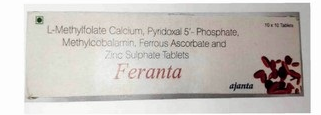ABSTRACT The project employs doctrinal research methods, i.e. secondary research which involves writing on basis…
Case Summary of “Ajanta Pharma Ltd. v Theon Pharmaceuticals Ltd.”
This article summarises the judgment of High Court of Bombay dated 5th May 2017 in the case “Ajanta Pharma Ltd. v Theon Pharmaceuticals Ltd.”.
FACTS:
The case has been filed before the Bombay High Court by Ajanta Pharma Ltd. (hereinafter “Plaintiff”) seeking interim relief in a pharmaceutical trade mark and passing off action against Theon Pharmaceutical and Intas Pharmaceutical (hereinafter “Defendants”). Initially when the lawsuit was brought, the claim of the Plaintiff was against the use of the mark “FERINTA” by the defendant which was deceptively similar to the mark of the Plaintiff i.e. “FERANTA”. Later, the defendant agreed to discontinue using the mark and it started using “INTAS’ FERINTAS”, with the letter FER in black, and the rest in a rust red color and FERINTAS set in an oval lozenge device. Now the Plaintiff has sought an injunction order against the defendants for the use of the mark “INTAS’ FERINTAS” under the provisions of the Trade Marks Act, 1999 (hereinafter “the Act”).
ARGUMENTS ADVANCED:
The defences taken by the Defendants –
- The first defence is also known as the ‘copycat defence’ which means that the Plaintiff has indulged in copying of another mark and therefore, they cannot take an action against the Defendants.
- The second defence was that the Plaintiff goods were sold as a pharmaceutical drug whereas the Defendant’s goods were sold as a food or dietary supplement. The goods are different and the slightest difference in the formulation or the prescribed use is sufficient.
- The third defence was that the Defendants were honest in adopting their mark. The Defendants have coined their mark by combining the principal ingredient and the main purpose with their corporate name. So the mark was coined as FER-INTAS from Ferrous and INTAS.
- It was further contended that Class 05 has a wide sweep and within that class if the Plaintiff has used their mark only for pharmaceutical and never for a food supplement then there is no likelihood of confusion. Therefore, the present case falls under the ambit of Section 29(2) of the Act.The test in 29(2) is not of deceptive similarity, but of likelihood of confusion; and, therefore, if this likelihood of confusion is not established, no injunction can be granted.
The counter arguments taken by the Plaintiff –
- The first counter argument was that the Plaintiff is not guilty of copying its mark. The mark’s registration lapsed in 1989; and it was never in use but only ever proposed to be used.
- The second counter argument was that the goods were registered under the same class and no such sub-classification can be made to differentiate the goods. According to the Nice Classification, pharmaceuticals include dietary and meal supplements and dietetic foods adapted for medicinal use (but, importantly, do not include meal supplements and dietetic foods not for medicinal use). Also, the ingredients of both the goods are precisely the same and they serve the same purpose. Both the goods are sold to treat Anaemia.
- It was contended that the Defendants were aware about the Plaintiff’s prior registration. Also, in an infringement action, honesty in adoption of a mark is totally irrelevant to a question of deceptive similarity.
- It was contended that the Defendants’ mark is similar; used in relation to similar, and possibly identical goods; and results in the Defendants’ mark, or the goods under it, being associated with the Plaintiff’s mark and therefore, the goods are deceptively similar.It was further contended that the injunction is demanded on public interest and if the Defendants are allowed to use the mark it will harm the public interest.
DECISION OF THE COURT:
The Court held that –
- The two marks have to be seen has a whole to determine if there are any chances of confusion. The test is the impression of a consumer who is of average intelligence and imperfect recollection.
- There is no prima facie case made out against the Defendants and no injunction order can be granted.
CONCLUSION:
The Court while adjudicating on the question of whether the marks are similar or not observed that the Plaintiff’s mark is a word mark whereas the Defendant’s mark is a composite word and label mark which uses a distinctive black-and-red colour combination. Also, it serves a dual purpose: it visually and structurally distinguishes the Defendant’s product from the Plaintiff’s product, and it proclaims proprietorship and ownership in its product. The Honorable Court placed reliance on the case of JR Kapoor v Micronix India,1994 Supp (3) SCC 215 and held that the two marks have to be compared as a whole to see if there are any remotest chance of buyers and users being misguided or confused. The Court, therefore, held that the two marks have to be compared as a whole and any dissection of the mark is unacceptable.
The Court referred to the case of Indchemie Health Specialties Pvt. Ltd. v Intas Pharmaceuticals Ltd., 2015 (63) PTC 391 (Bom) observed that “Whether or not we should make fine distinctions when looking at goods that, though in the same ‘class’, are used in distinct ways is a question that would arise if one found a similarity in the marks to begin with.” The Court further observed that if the Plaintiff’s argument regarding the Nice Classification is accepted, it is clear that Class 05 does not include meal replacements, dietetic food and beverages not for medical or veterinary use. If the Defendant’s product can be proved to be such a dietetic food then it is another point of distinction.
The Court rejected the contention of harming public interest by referring to the case of Shaw Wallace & Co. Ltd. v Mohan Rocky Spring Water Breweries Ltd.2006 (4) Mh LJ 396, stating that the public is required to be protected from being deceived but that would be a point of contention when the two marks are similar. The Court rests the other counter-arguments of the Plaintiff by stating that “If no similarity is found and a prima facie is not made out, then there is no question of even having to consider the question.”
The Hon’ble Court held that the mark FERANTA is not deceptively similar to the markINTAS’ FERINTAS and no prima facie case can be made out therefore no injunction can be granted against the Defendants.
Author: Ankita Aseri, Intern at Khurana & Khurana, Advocates and IP Attorneys. In case of any queries please contact/write back to us at swapnils@khuranaandkhurana.com.





